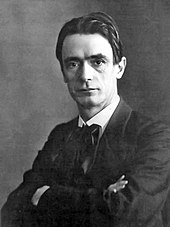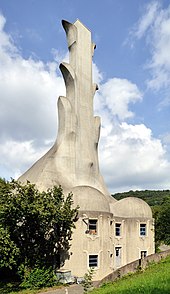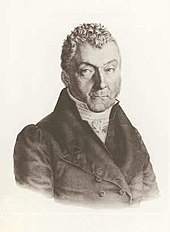Anthroposophy
Anthroposophy (from the ancient Greek ἄνθρωπος ánthrōpos "human being" and σοφία sophίa "wisdom") is the name given to a spiritual and esoteric worldview founded by Rudolf Steiner (1861-1925) and represented worldwide, as well as the associated path of education and knowledge. Anthroposophy attempts to combine elements of German idealism, Goethe's worldview, gnosis, Christian mysticism, Far Eastern teachings, and the scientific findings of Steiner's time. One of the main sources of anthroposophical teaching is the knowledge that Rudolf Steiner himself says he gained from his explorations of a spiritual world that existed for him.
A central aspect was and is an application of the idea of evolution to spiritual development. In doing so, Steiner incorporated evolutionary approaches of both the Darwinist Ernst Haeckel and modern theosophy as represented by Helena Petrovna Blavatsky. Anthroposophy seeks - in contrast to representatives of a purely secularly scientifically oriented idea of progress - to understand humanity and its development spiritually and supersensually, but in doing so it sets itself apart from theosophy and its orientation towards Eastern religiosity. As with Haeckel and other contemporaries of Steiner, the inclusion and reinterpretation of evolution led to controversies about possible social Darwinist and racist aspects.
Inspired by Steiner's ideas, an "application anthroposophy" exists in many areas which contributes to the attractiveness of the anthroposophical movement to this day. These include anthroposophical architecture, Waldorf education, anthroposophical medicine, Weleda brand natural cosmetics, biodynamic agriculture, eurythmy and The Christian Community.
Concept and effect
Rudolf Steiner understood anthroposophy on the one hand as a comprehensive ("cosmological") view of the human being and the world, which he advocated and disseminated as a doctrine, and on the other hand as a path of knowledge as a scientific method for investigating the supersensible ("spiritual"). He chose the term "anthroposophy" as a contrast to the term "anthropology". The latter dealt with what man could experience of the world through his senses and the intellect that adhered to sensory observation; the former, on the other hand, contained the "knowledge of the spiritual man" and extended to everything that he could perceive in the "spiritual world", i.e. in the supersensible.
Synonymous with the term "anthroposophy" Steiner also used other terms such as "theosophy", "secret science" or "spiritual science" to denote his teaching and his "research method". However, he spoke of "theosophy" only during his activity within the framework of the Theosophical Society (1902-1913). "Spiritual science", on the other hand, was still a synonymous term used by him later for his conception of the world. In this Steiner evidently drew on Wilhelm Dilthey, the founder of the philosophy of life, to whose "Introduction to the Spiritual Sciences" he referred approvingly at various points. Unlike Dilthey, in anthroposophy spiritual science is understood to be a methodically trained supersensible acquisition of knowledge. Steiner assumed that the power of thought could be trained like a muscle through systematic practice. In 1904/05, in a series of essays entitled "How to gain knowledge of the higher worlds", he explained how, through concentration and meditation under the guidance of an experienced teacher, an intuitive vision of "higher spheres" could be achieved. This methodology drew on Buddhism, yoga, and the theosophy of Helena Petrovna Blavatsky.
Steiner used the term "anthroposophy" as the title of a fragmentary text from 1910 (Gesamtausgabe [GA] 45). For Steiner, anthroposophy is the creation of a consciousness of humanity. He is concerned with the formulation of a comprehensive epistemology for the development of human consciousness. Since, according to Steiner, the dualistic separation of "I" and "world" is overcome in the act of cognition, his anthroposophy aims to offer guidance for "man's knowledge of himself and of the world" at the same time. This is the monistic programme of the anthroposophical path of knowledge, which - with Friedrich Nietzsche and Max Stirner - presupposes a free, individualistic human being. This variety of monism unites knowledge of nature and anthroposophical knowledge of the spirit, in that nature and the spiritual world are regarded as parts of one world.
Anthroposophy had and still has important supporters, mainly from the field of cultural life, namely art, including the visual artists Joseph Beuys, Wassily Kandinsky, Oscar Lüthy and Franz Marc, the composer Viktor Ullmann, the composer and musicologist Peter-Michael Riehm and the conductor Bruno Walter, the writers Saul Bellow, Andrej Bely, Michael Ende and Christian Morgenstern. Sympathizers included Alexej (von) Jawlensky, Jorge Luis Borges, Piet Mondrian, Richard Neutra, Le Corbusier, Henry van de Velde, Frank Lloyd Wright, Eero Saarinen, Erich Mendelsohn, and Hans Scharoun (see also Organic Architecture). Of the architects alive today, Frank Gehry in particular cites Steiner as a source of inspiration.
Steiner's influence can be detected beyond the circle of direct followers. Hermann Hesse, who had a distanced relationship to Steiner's teachings, published various poems around 1926/1927 in the journal Individualität, which was edited by the anthroposophical founding member and temporary Steiner secretary Willy Storrer. Paul Klee also received Steiner with a critical distance. Part of this influence of Rudolf Steiner on various art movements is only gradually being addressed.

Rudolf Steiner around 1905

Steiner's architectural style was the model for organic architecture. The picture shows the heating house of the Goetheanum
Term History
The term "anthroposophy" was already used in early modern times. In an anonymous book entitled Arbatel de magia veterum, summum sapientiae studium (1575), attributed to the philosopher and theologian Agrippa von Nettesheim, anthroposophy (like theosophy) is attributed to the "science of good" and translated as "knowledge of natural things" or "prudence in human affairs". In 1648 the Anthroposophia Theomagica of the Welsh philosopher Thomas Vaughan appeared.
At the beginning of the 19th century, the Swiss physician and philosopher Ignaz Troxler (1780-1866) coined the term "anthroposophy" in reference to his Biosophy (Elements of Biosophy, 1806). In the sense of the forerunners of the philosophy of life, especially the natural philosopher Schelling, under whom Troxler had studied, biosophy was to mean "knowledge of nature through self-knowledge". Troxler called the knowledge of human nature anthroposophy. According to him, philosophy - and all philosophy is knowledge of nature - must become anthroposophy. This is presented as an "objectified anthropology" which is to start from the "original human being". In human nature, therefore, God and the world unite in a mystical process.
Immanuel Hermann Fichte also used the word anthroposophy in 1856 in Anthropology - The Doctrine of the Human Soul, referring to a "thorough self-knowledge of the human being" that lies "only in the exhaustive recognition of the spirit". However, the "human spirit" could not know itself in a truly thorough or fathoming way without thereby becoming aware of the "presence or proving of the divine spirit in it".
The philosopher of religion Gideon Spicker, who aspired to a "religion in philosophical form on a scientific basis" and regarded the conflict between faith and knowledge, between religion and natural science, as the basic problem of his life and thought, formulated the programme of an anthroposophy, also in the sense of "highest self-knowledge". Spicker's ideal embraced in religion the unity of God and the world as self-responsible knowledge using reason and experience.
The Austrian philosopher and herbartian Robert Zimmermann (1824-1898), creator of the "Philosophical Propaedeutics", chose the term "anthroposophy" in 1882 as the title of a pamphlet that sought to describe a system of ideal worldview on a realistic basis (Anthroposophy in Outline, 1882). Zimmermann, with whom Steiner listened to philosophy lectures, wanted in his system to go beyond the "barriers and contradictions inherent in the common standpoint of experience" and to establish a "philosophy of human knowledge" which, as a science, proceeds from experience but reaches beyond it where logical thinking requires it.
Rudolf Steiner initially used the name "anthroposophy" in a very free way. In 1902, for example, he gave a series of lectures in the Berlin literary circle he led, Die Kommenden, entitled: Von Zarathustra bis Nietzsche. History of the Development of Mankind on the Basis of World Views from the Most Ancient Oriental Times to the Present, or Anthroposophy. Nothing more is known about the content of these lectures. At the same time, he spoke publicly for the first time (within the framework of the Giordano Bruno Association) about the theosophy he represented from then on (title: Monism and Theosophy), whereby he linked up with Immanuel Hermann Fichte in terms of content. Within the framework of the Theosophical Society, Steiner used the term "anthroposophy" for the first time in 1909, namely for an extended sense doctrine. This he placed alongside the already existing theosophy, "similar to the way anthropology was placed alongside theology in the Middle Ages" (Anthroposophy, Psychosophy, Pneumatosophy, GA 115). After he had called a historical consideration of world views "Anthroposophy" in 1902, he now developed a sense doctrine under the same name, which supplemented the known five senses by five further senses and was thus to form a bridge between theosophy and anthropology. Concerning the history of the word, he remarked: "The word has already been used once. Robert Zimmermann wrote an anthroposophy, but he undertook it with most inadequate means [...]. He spun it out with the most exhausted, abstract concepts, and this gossamer was then his anthroposophy." Steiner did not finish a written version of his "anthroposophical" theory of the senses; it was published posthumously as a fragment (Anthroposophy - a Fragment, GA 45).
When in 1913 there was a break with the Theosophical Society and Steiner had to choose a new name for what he had hitherto represented as "Theosophy", he decided on "Anthroposophy".

Ignaz Paul Vitalis Troxler was the founder of an anthroposophy which he derived from biosophy
Questions and Answers
Q: What is Anthroposophy?
A: Anthroposophy is a philosophical system founded by Rudolf Steiner that teaches that through inner development, one can gain a deeper understanding of the spiritual world.
Q: Who founded Anthroposophy?
A: Rudolf Steiner founded Anthroposophy.
Q: What does the word "Anthropos" mean?
A: The word "Anthropos" is a Greek word that means "human being."
Q: What does the word "Sophos" mean?
A: The word "Sophos" is a Greek word that means "wise."
Q: What did Rudolf Steiner believe about human beings?
A: Rudolf Steiner believed that every human being had the wisdom to understand the mysteries of existence.
Q: When did Rudolf Steiner leave the German Theosophical Society?
A: Rudolf Steiner left the German Theosophical Society in 1912.
Q: What did Rudolf Steiner trade for human wisdom in 1912?
A: In 1912, Rudolf Steiner traded divine wisdom for human wisdom when he left the German Theosophical Society.
Search within the encyclopedia